What to choose & when
In the ever-evolving field of neurosurgery, advancements in technology have given rise to various treatment modalities for conditions such as brain tumors and other neurological disorders. Three cutting-edge techniques that have gained prominence are Gamma Knife, Proton Beam, and CyberKnife treatments. Each of these approaches employs different principles and technologies to target and treat neurological conditions, offering unique advantages and considerations for both patients and healthcare professionals.
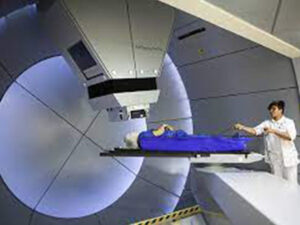
With proton therapy, the depth of radiation penetration into the body can be controlled, theoretically allowing protons to stop traveling when they reach the end of the tumor, thus reducing the radiation dose beyond the tumor. However, several technical factors limit the ability to precisely predict the exact stopping point of the particles.
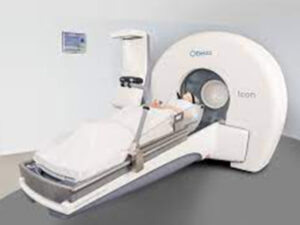
The photons that Gamma Knife treatment utilizes, however, deposit their radiation dose in a much more predictable manner and can precisely target tumors in very sensitive locations with unparalleled accuracy and precise control of a concentrated radiation dose to single or multiple tumors. Read the full post to learn more about these treatments.
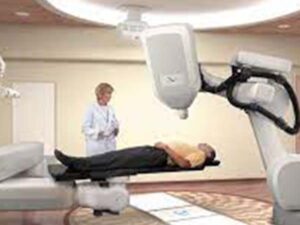
The CyberKnife device emits a narrow beam of radiation from a robotic arm that moves around the patient’s body to accurately target a tumor. Using brain scans taken before and during the procedure, the robotic arm automatically tracks and compensates for small movements.
What is Proton Beam Therapy?
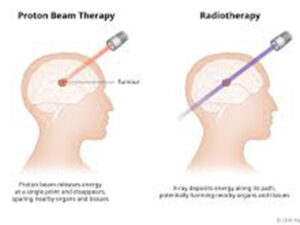
Proton beam therapy, sometimes called proton beam radiation therapy, is a non-invasive treatment that delivers radiation directly to your tumor. It utilizes protons, charged particles found in the nucleus of atoms, to deliver radiation to the targeted area. Unlike traditional photon-based radiation, protons have unique physical properties that allow for precise control over the depth of penetration, minimizing damage to surrounding tissues.
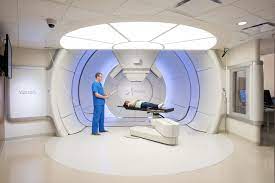
Proton therapy is particularly advantageous for treating deep-seated tumors or lesions near critical structures, as it allows for superior dose distribution.
It can be used to treat many different cancers all over the body. It is typically performed in an outpatient setting, with patients returning home the same day as treatment. Treatments are done over many days or weeks.
What is Gamma Knife Surgery?
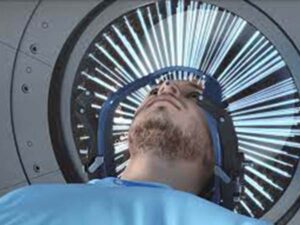
Gamma Knife radiosurgery is a non-invasive technique that uses precisely focused gamma rays to treat brain lesions or tumors. It is particularly effective for small to medium-sized lesions. The key feature of Gamma Knife is its ability to deliver a high dose of radiation with extreme accuracy, minimizing damage to surrounding healthy tissues. This is achieved by combining multiple radiation beams at a single point, resulting in a highly targeted and concentrated treatment.
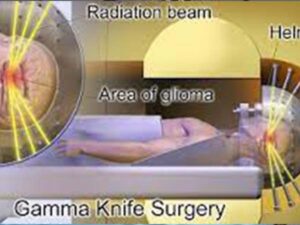
Gamma Knife Surgery What is CyberKnife Surgery?
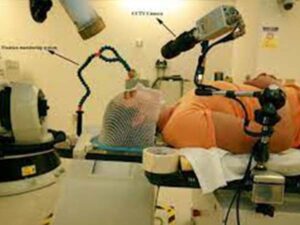
CyberKnife radiosurgery, similar to Gamma Knife, is a non-invasive treatment method that uses highly focused radiation beams. However, CyberKnife employs a robotic arm to deliver radiation from various angles, adjusting in real-time to the patient’s movements. This dynamic tracking feature allows for extreme precision, making Cyber Knife suitable for treating tumors or lesions in areas that are prone to movement, such as the spine or lungs.
Which option is right for you?
Precision and Accuracy:
- Gamma Knife is renowned for its extremely high precision due to its ability to focus radiation on the target with minimal impact on surrounding healthy tissues.
- Cyber Knife although precision is slightly less than gamma knife can treat tumors beyond the head and anywhere in the body.
- Proton Beam Therapy also offers precision, but less than both gamma knife and cyber knife, the advantage lies in its ability to control the depth of penetration, making it suitable for tumors at various depths within the body.
Tumor Location and Size:
- Gamma Knife excels in treating tumors, those located in the brain.
- Proton Beam Therapy is beneficial for treating deep-seated tumors lying close to critical areas making it suitable for lesions in the brain, spine, and other critical areas.
- CyberKnife dynamic tracking makes it versatile for treating tumors in areas with inherent movement, such as the spine.
Non-Invasiveness and Recovery:
- Gamma Knife, Proton Beam, and CyberKnife treatments are all non-invasive, reducing the need for surgical intervention.
- Recovery times for these treatments are generally shorter compared to traditional surgical approaches.
Side Effects:
- The risk of side effects in all three treatments is relatively low due to their precision. However, the nature and severity of potential side effects may vary based on the specific treatment and the patient’s factors.
Comparison Between Gamma Knife, Proton Beam, Cyber Knife.
| Treatment | Gamma Knife | Proton Beam | CyberKnife |
| Localization | It is a both frame-based & frameless radiosurgery technique. | It is a frameless radiosurgery technique. | It is a frameless radiosurgery technique. |
| Precision | Highest accuracy of <0.3 mm | Lower accuracy of 3.6 mm. | Lower Accuracy 1.1 -+ 0.3 mm. |
| Best Suited For | It is designed to target tumors within the skull or cervical spine tumors. | It treats the whole body. | It can treat tumor cells from multiple angles anywhere in the body. |
| Indications | It is used to treat brain tumors, arteriovenous malformations, trigeminal neuralgia, acoustic neuroma, and skull-based tumors. | It is used to treat lesions all over the body. | It is used to treat lesions all over the body. |
| Radiation Sources | It employs cobalt radiation sources in a mixed hemispherical array, such that all photon beams focus on a single point. It uses intense beams of gamma rays with pinpoint accuracy to treat functional abnormalities in the brain. | A machine called a synchrotron or cyclotron speeds up protons. The high-energy protons travel to the desired depth in the body. The protons then give a targeted radiation dose to the tumor. | They deliver their radiation beams one at a time instead of delivering radiation into convenient primitive shapes for precise target delineation. It uses a robotic arm to deliver radiation beams to the targeted tumor from multiple positions and angles to destroy tumor cells. |
| Why Frame Based | The head frame is required for sub-millimeter accuracy. | Cannot use the head frame hence sub-millimeter accuracy is not possible. | The head frame is not required for sub-millimeter accuracy. |
| Sedation or Anesthesia Required | Only local anesthesia is given during frame fixation. No Anesthesia in frameless methods. | Anesthesia is often required so that the patient lies still and the beam can be directed accurately. | No anesthesia is required. |
| Treatment Duration | Single session The treatment session may last 10 min to 4 hours. | A typical course of treatment is 5 days per week for several weeks. The proton beam treatment only takes a few minutes, but preparation and positioning take longer. | Multiple sessions The treatment generally lasts between 30 and 90 minutes. |
| Is it Painful | It is a painless computer-guided treatment that delivers highly focused radiation to tumors and lesions in the brain. | It is usually painless. | It is a painless treatment. |
| Treatment Pricing | Cost can range from approximately Rs.2,80,000 to Rs.5,60,000 in private hospitals whereas, it starts from Rs.75000 in AIIMS. | Cost can vary between Rs.50 lakhs to Rs.1 crore. | Cost may range from Rs.80,000 – Rs.100,000 |
- Proton therapy is better suited for infiltrative primary tumors, or cancer that starts and grows throughout the body and needs to be treated over many weeks. However limited data is available.
- Gamma Knife is recommended for brain and skull-base lesions. We recommend a gamma knife over a proton beam and a cyber knife whenever it can be given.
- CyberKnife can treat tumors in the brain, head, neck, and throughout the body. The Gamma Knife, however, is limited to cancers in the brain and limited cervical spine areas, where movement can be stabilized with invasive head frames.
Gamma Knife tends to be significantly less expensive as it starts from Rs.75000 than cyber knife and proton beam therapy as the cost of cyber knife therapy tends to be Rs.80,000 – Rs.100,000 and proton beam therapy tends to be Rs.50 lakhs to Rs.1 crore.
Summary
- For brain & skull-base lesions we recommend a gamma knife over the proton beam and a cyber knife whenever it can be given.
- For lesions anywhere else in the body cyber knife and/or proton beam can be considered. However, cyber-knife is significantly cost-effective as compared to proton beam
- For lesions that are very close to critical structures like the optic nerve (vision nerve) or brain stem a deeply located proton beam therapy can be considered. However, data is still lacking regarding its superiority over gamma knife/cyber knife.
Conclusion:
In the field of neurosurgery, Gamma Knife, Proton Beam, and CyberKnife treatments represent cutting-edge technologies that offer effective and precise alternatives to traditional surgical interventions. The choice among these modalities depends on factors such as tumor size, location, and the patient’s overall health.
As technology continues to advance, these treatments will likely play an increasingly pivotal role in the comprehensive care of patients with neurological disorders. Healthcare professionals must stay informed about these evolving technologies to provide the best possible treatment options for their patients. Also, it is advised for every patient to consult the concerned healthcare professional before going for any of these treatment processes.
Khyati Pathak
TV Health
Inputs Taken From
Dr. Deepak Agrawal, MBBS, MS, MCH
Professor of Neurosurgery & Gamma-Knife at AIIMS, New Delhi
